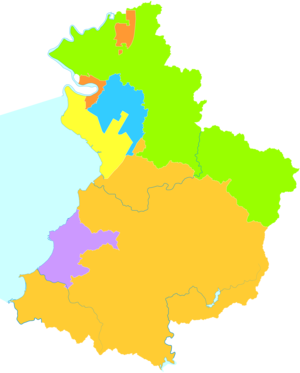Yingkou
Yingkou ( Chinese 營口 市 / 营口 市 , Pinyin Yíngkǒu Shì ) is the second largest port city in northeast China after Dalian . As a district-free city , it has an area of 4,970 km² and around 2,350,000 inhabitants (2010). Yingkou is located about 220 km north of Dalian and about 200 km south of the provincial capital Shenyang . Yingkou is connected to the rail network of Liaoning Province and also has an exit on the Shenda Expressway, which connects the cities of Shenyang and Dalian. Yingkou is currently the eighth largest city in Liaoning Province. Yingkou is located on the Liao He River .
Administrative structure
| Yingkou Boroughs |
|---|
At the county level, Yingkou consists of four urban districts and two independent cities. These are:
- District Zhanqian (站前区), 70 km², 260,000 inhabitants
- Xishi district (西 市区), 20 km², 160,000 inhabitants
- Bayuquan district (鲅鱼圈 区), 268 km², 300,000 inhabitants
- Laobian district (老 边区), 305 km², 130,000 inhabitants
- Dashiqiao city (大 石桥 市), 1,379 km², 720,000 inhabitants
- Gaizhou City (盖州市), 2,928 km², 730,000 inhabitants
economy
Yingkou's economy is primarily shaped by the port and the vehicle supplier industry . There are a number of factories that manufacture engine components along the outskirts of the city. This also includes German companies such as Stuttgart Mahle GmbH and Fuchs Petrolub SE .
The important port ( sea port ) of Yingkou is largely ice-free in winter. In 2014, 5,768,200 TEU were loaded in the container port .
history
The port of Niuzhuang ( Chinese 牛庄 , Pinyin Niúzhuāng , English Newchwang ), located about 50 kilometers north of today's city of Yingkou on the Liao He river, was opened to international trade with the Treaty of Tianjin in 1858. However, it turned out that the river was too shallow for the British ships. As a result, the port was moved closer to the river mouth to its current location.
During the Sino-Japanese War , Yingkou was the scene of a major battle. In 1895 the city was captured by the Imperial Japanese troops. The outnumbered Chinese had put up bitter resistance to the last in a fort on the western edge of the city on the Bohai coast.
After World War II , Yingkou was under the control of the nationalist Kuomintang . In the course of the looming defeat, the Kuomintang evacuated its remaining troops in the port of Yingkou in 1949 and fled to Taiwan. With that the presence of the Kuomintang in the northeast of China was extinguished.
Culture and tourism
In Yingkou there is a park with a Buddhist temple that is famous in Liaoning Province. The river promenade is also a focal point. In summer many musicians, singers and dancers can be admired on the river promenade, which is connected to a park.
There is also a Catholic church and a Sunni mosque in Yingkou.
Coordinates: 40 ° 40 ′ N , 122 ° 14 ′ E


